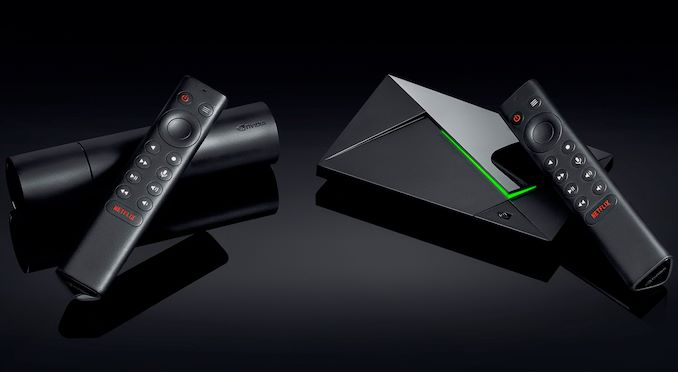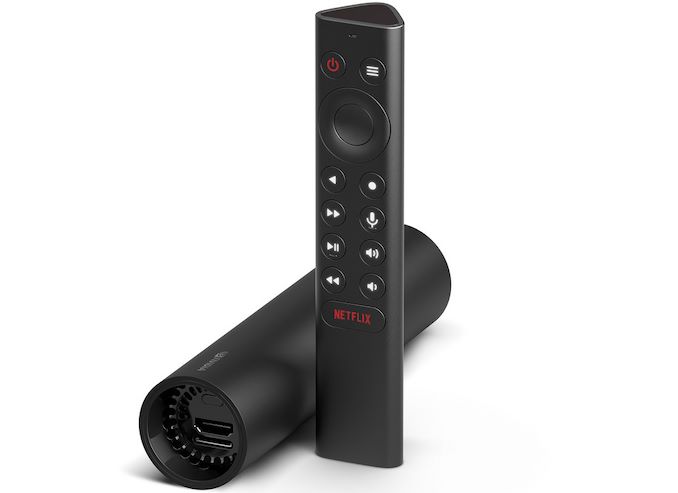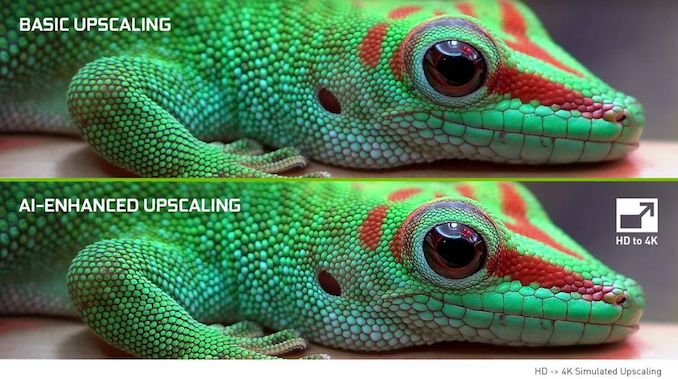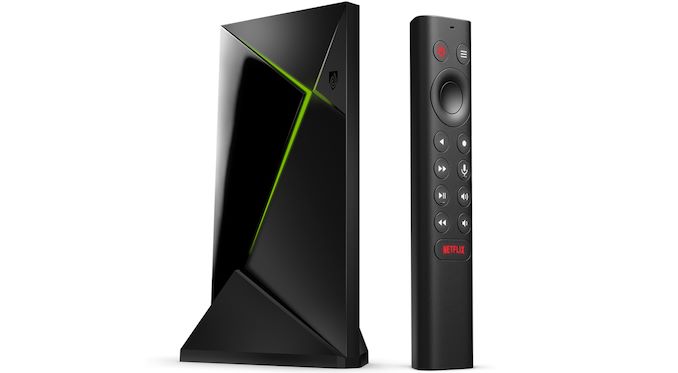NVIDIA Reveals New SHIELD TV: Tegra X1+, Dolby Vision, Dolby Atmos
by Anton Shilov on October 29, 2019 11:00 AM EST
NVIDIA has introduced new versions of its SHIELD TV set-top-boxes featuring an all-new design as well as based on an improved Tegra X1+ SoC. The new STBs support all the features its predecessors do and add support for Dolby Vision HDR, Dolby Atmos audio, as well as a new AI-powered upscale algorithm. With the launch of the new devices NVIDIA somewhat changes concept of its STBs as they no longer come with a gamepad.
The new NVIDIA SHIELD TV devices use the company’s new Tegra X1+ SoC that is said to be 25% faster when compared to the original one launched over four years ago. The chip essentially has the same feature set and Maxwell graphics, so games developed with the original SoC in mind will work with the new one without any problems. Meanwhile, since the Tegra X1+ is made using a more advanced process technology, this allows NVIDIA to offer the new SHIELD TV in a more compact form-factor. At the same time, the new SoC is paired with 2 GB of RAM (down from 3 GB) as well as 8 GB of NAND flash storage (down from 16 GB previously), which can be expanded using a microSD card. The SHIELD Pro has 3 GB of RAM as well as 16 GB of NAND storage, but no longer has a hard drive.
NVIDIA made its new SHIELD TV smaller than the predecessor in a bid to better compete against compact streaming media device, such as Google’s Chromecast/Chromecast Ultra. From connectivity standpoint, the new STB features Wi-Fi 5, Bluetooth 5.0, a GbE port, an HDMI 2.0b output with HDCP 2.2, and a microSD card slot. Meanwhile, it no longer has USB 3.0 ports, possibly to save space and simplify design. Those who need USB 3.0 should buy the SHIELD Pro with two USB Type-A ports.
| NVIDIA SHIELD STB Family | ||||||
| SHIELD TV (2019) |
SHIELD TV Pro (2019) |
SHIELD TV (2017) |
SHIELD TV Pro (2017) |
SHIELD Android TV (2015) |
||
| SoC | Tegra X1+ | Tegra X1 (4 × Cortex A57 + 4 × Cortex A53, Maxwell 2 SMM GPU) |
||||
| RAM | 2 GB | 3 GB | 3 GB LPDDR4-3200 | |||
| Storage | 8 GB NAND microSD |
16 GB NAND USB |
16 GB NAND USB |
16 GB NAND 500 GB HDD microSD USB |
16 GB NAND 500 GB HDD (Pro only) microSD USB |
|
| Display Connectivity | HDMI 2.0b with HDCP 2.2 (4Kp60, HDR) | |||||
| Dimensions | Height | 40 mm 1.57 inch |
98 mm 3.858 inch |
130 mm 5.1 inch |
||
| Width | 40mm 1.57 inch |
159 mm 6.26 inch |
210 mm 8.3 inch |
|||
| Depth | 165 mm 6.5 inch |
26 mm 1.02 inch |
25 mm 1 inch |
|||
| Weight | 137 grams | 250 grams | 654 grams | |||
| Power Adapter | integrated | ? | 40 W | |||
| I/O | Wireless | 2x2 802.11a/b/g/n/ac Bluetooth 4.1/BLE |
||||
| USB | - | 2 × USB 3.0 | 2 × USB 3.0 1 × micro-USB 2.0 |
|||
| IR | - | - | - | IR Receiver | ||
| Ethernet | Gigabit Ethernet | |||||
| Launch Product Bundle | Shield Remote | Shield Controller Shield Remote |
Shield Controller | |||
| Launch Price | $149.99 | $199.99 | $199.99 | $299.99 | Basic: $199.99 Pro: $299.99 |
|
When it comes to decoding capabilities, the new SHIELD TV can decode H.265/HEVC, VP8, VP9, H.264, MPEG1/2, H.263, MJPEG, MPEG4, and WMV9/VC1 video. Meanwhile, the STB does not support AV1 as well as VP9.2 codecs because they are not widespread at the moment. The new SHIELD TV can playback 4Kp60 HDR, 4Kp60, Full-HD 60 fps content, and can upscale 720p and 1080p content to 4Kp30 using an AI-enhanced algorithm. It is unclear whether the algorithm relies on a new hardware block that is present only inside NVIDIA’s Tegra X1+, or uses a combination of hardware and software, which means that it could be enabled on previous-generation SHIELD TV consoles too
| NVIDIA's 2019 SHIELD TV STBs | |||
| Video | |||
| 4K HDR at 60 FPS | H.265/HEVC | ||
| 4K at 60 FPS | VP8, VP9, H.264, MPEG1/2 | ||
| 1080p at 60 FPS | H.263, MJPEG, MPEG4, WMV9/VC1 | ||
| HDR | HDR10, Dolby Vision | ||
| Containers | Xvid/ DivX/ASF/AVI/MKV/MOV/M2TS/MPEG-TS/MP4/WEB-M | ||
| Audio | |||
| Audio Support | AAC, AAC+, eAAC+, MP3, WAVE, AMR, OGG Vorbis, FLAC, PCM, WMA, WMA-Pro, WMA-Lossless, Dolby Digital Plus, Dolby Atmos, Dolby TrueHD (pass-through), DTS-X (pass-through), and DTS-HD (pass-through) | ||
| High-Resolution Audio Playback | up to 24-bit/192 kHz over HDMI and USB | ||
| High-Resolution Audio Upsample | up to 24-bit/192 kHz over USB | ||
The new SHIELD TV STBs come with a redesigned SHIELD remote with improved ergonomics and more buttons. The unit has a built-in microphone for Google Assistant and Amazon Alexa; motion-activated backlit buttons; Bluetooth connectivity to connect to the player; and an IR blaster to control volume and power on TVs, soundbars or receivers.
Being based on Android TV/Android 9.0 (Pie) platform, the SHIELD TV ships with a variety of content deliver apps, including Netflix, YouTube, Amazon Prime Video, Amazon Music, Vudu, Google Play Movies & TV, Plex, Google Play Games, NVIDIA Games, and Google Games. End-users may install additional apps themselves if they need to.
Because of the simplified design and the lack of bundled gamepad, the new NVIDIA SHIELD TV media players are cheaper than their predecessors: the base model costs $149.99 (down from $199.99), whereas the Pro model is priced at $199.99 (down from $299.00).
Related Reading:
- SHIELD TV Now Supports 120 Hz Refresh, Ups Wi-Fi Bandwidth for GeForce NOW
- NVIDIA Unifies GeForce NOW Service Across PCs and SHIELD TV STBs: 200+ Games Supported
- NVIDIA Temporarily Slashes $30 Off the SHIELD TV: Now Staring at $149
- NVIDIA Releases Android 7.0 Update for 2015 SHIELD TV, Adds Amazon Video App
- NVIDIA Launches SHIELD TV: Smart Home Functionality, More 4K HDR Streaming Services
- NVIDIA SHIELD Android TV Console Adds Support for Vudu, HDR and 4Kp60 Content
Source: NVIDIA













80 Comments
View All Comments
abufrejoval - Tuesday, October 29, 2019 - link
Perhaps a new Jetson Nano based on the impoved SoC?mammothboy - Tuesday, October 29, 2019 - link
Can it really do VC1? The older models seem to chug and fail on old HD-DVD VC1 rips using in Kodi. I'm sure it's more a licensing ROI issue vs actual capabilities. Everything else always plays well.nathanddrews - Tuesday, October 29, 2019 - link
I'm pretty sure it's not VC-1 that causes it, but specifically the implementation of Dobly TrueHD or Dolby Digital Plus found on HD-DVD. The fix (for me) has always been to change the audio source to stereo or standard Dolby Digital. YMMVHixbot - Saturday, November 2, 2019 - link
Very disappointed Nvidia hasn't launched HDMI 2.1 yet.mammothboy - Tuesday, October 29, 2019 - link
Can it really do VC1? The older models seem to chug and fail on old HD-DVD VC1 rips using in Kodi. I'm sure it's more a licensing ROI issue vs actual capabilities. Everything else always plays well.Operandi - Tuesday, October 29, 2019 - link
I honestly can't see any difference between those two upscaled images....SirMaster - Tuesday, October 29, 2019 - link
You might need glasses. I see clear differences looking casually on my 23" 1080p from 1.5ft away.imaheadcase - Tuesday, October 29, 2019 - link
That is not how pictures work online...lolPeachNCream - Tuesday, October 29, 2019 - link
Maybe if you turn off your adblocker to view Anandtech, it makes the differences pop out at you. Either that or you get brain cancer and the tumor makes the images look different.PeachNCream - Tuesday, October 29, 2019 - link
I'm having trouble really seeing a substantial improvement. There is a minor increase in sharpness, I think, but I'm not sure it matters.